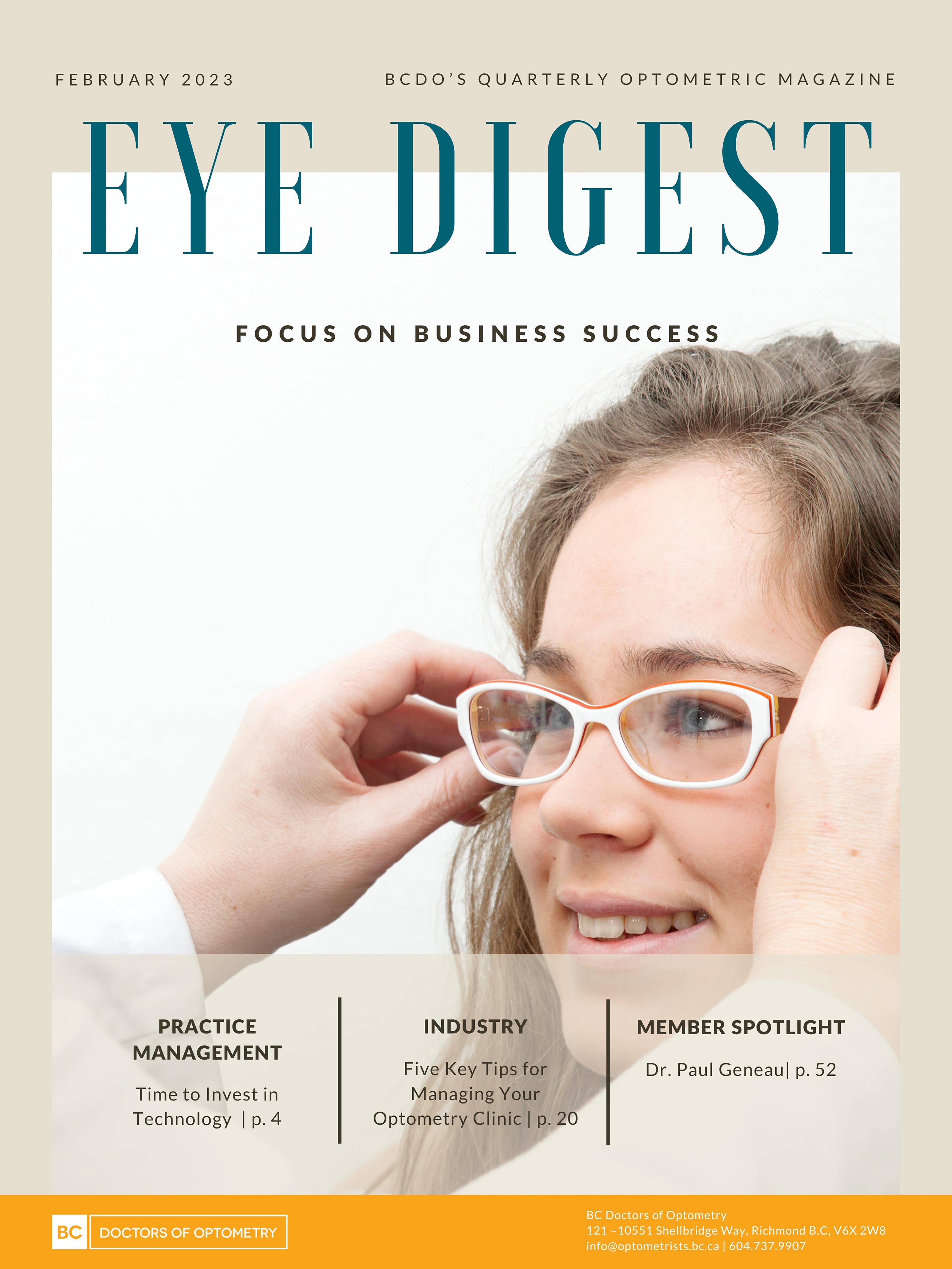
CONTENTS BCDO Annual Conference and OPTOFAIR Registration 3 Time to Invest in Technology 4 Canadian Dry Eye Summit 6 OA Program 2023 ...................................................................................................................... 7 Myopia Management Tips 9 BCDO Gala 2023 ....................................................................................................................... 11 Cycle for Sight 12 Advances in Stem Cell Therapy Made by FBC-Funded Researcher 13 Acuvue Oasys Max .................................................................................................................. 15 Shaping the Future of Eye Care 16 Call for Nominations for BCDO Awards 2022 .............................................................. 18 The Scotia Professional Plan for Optometrists 19 Five Key Tips for Managing Your Optometry Clinic .................................................. 20 Acuvue: Life Demands More of Our Eyes 22 In With the New 24 The Technology Suite that Helped Me Jump-Start a Fast-Growing Practice Right Out of OD School 27 Topcon Healthcare: Maestro2 ............................................................................................ 28 Onboard the Leadership Bus 30 Earn Cope CE Credits 33 The Optimum Experience with EyeSafe 35 Building a Successful Business Starts with a Strong Foundation 37 Portfolio Planning ................................................................................................................... 39 BCDO is Giving Optometrists the Gift of Financial Wellness 40 BCDO partnership with UWaterloo’s School of Optometry Committed to Indienous vision health initiatives 44 Employer Advice: How Retaining Staff can Help with the Business’s Overall Success ............................................................................................................... 47 Alcon: Total Comfort Meets Proven Stability 48 Alcon Launches New TOTAL Toric Lenses for Astigmatic Patients ..................... 49 OPTOFAIR 2023 51 Member Spotlight – Dr. Paul Geneau .............................................................................. 52 Perkopolis 58 BCDO Cocktail Hour 2023 59 Expanding Doctor Generated Content .......................................................................... 60 Are You Interested in Locum Work? Let Us Know! 62
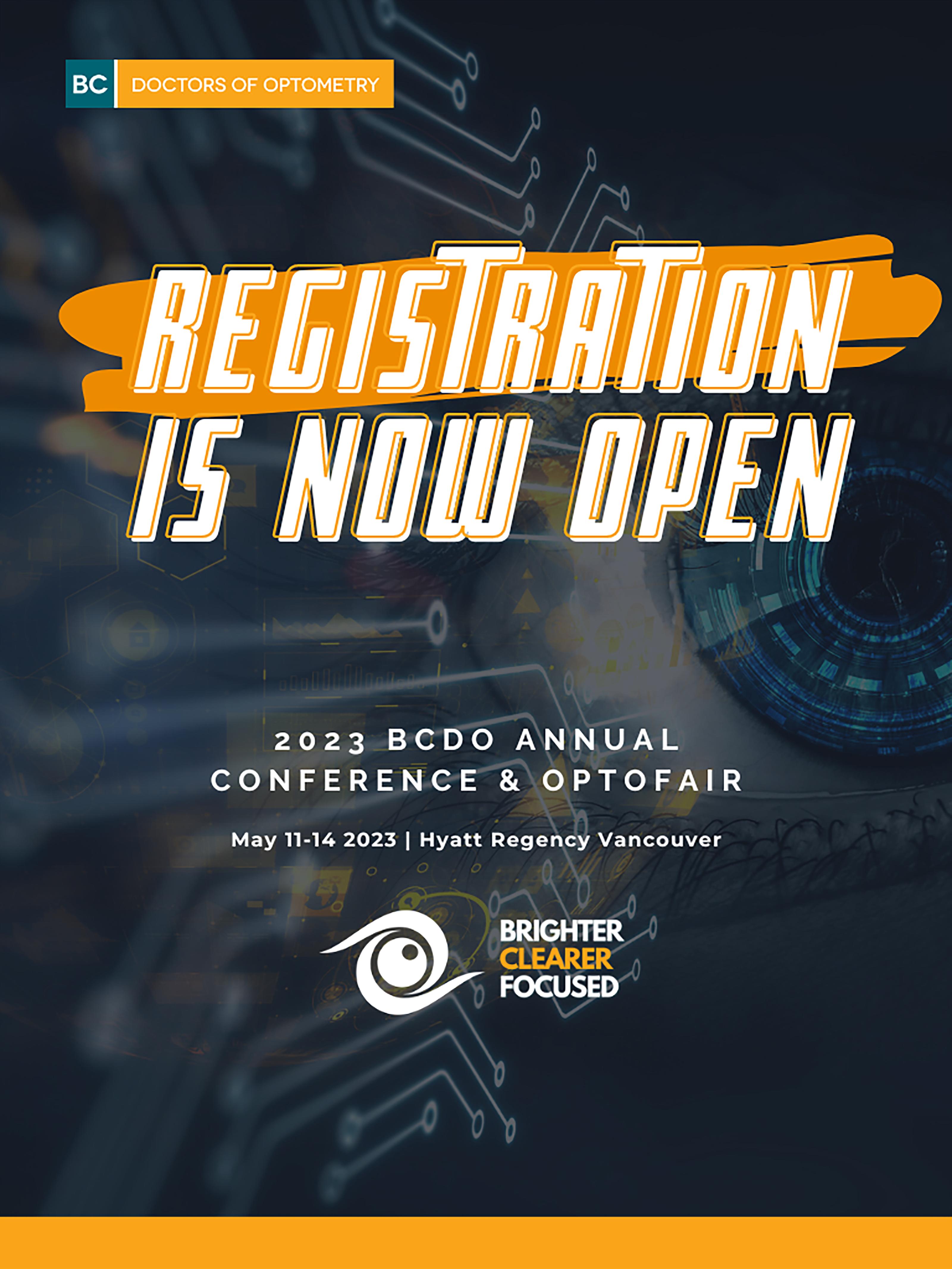
Register Now
By Dr. Trevor Miranda, OD Disclosures: Consultant for Neurolens, Founder Dry Eye Summit

You have a busy practice and work is going quite well. Your clinic looks great and has a growing patient and revenue base. You initially bought the latest technology to start your clinic. Wide Field Retinal imaging, OCT and perhaps some other great diagnostic or treatment tech. You have paid off some of the scary bank debt and you’re starting to feel like owning your practice actually was a smart idea and a good investment! When is it time to reinvest in your practice? When is it time to buy into new technology? In this article, we will examine some factors to consider when looking at the next tech.
Budget
Cash flow analysis is important. Are debt loads sustainable? Every year we budget for everything. Revenues and expenses are broken down into estimated projections and profitability levels are set and monitored throughout the year. In our clinics, we set 3% of revenues to our equipment
expenses. If you are below 3% you may want to consider a reinvestment into the next revenue generating or profit creation technology.

Contribution Margin
The contribution margin is computed as the selling price per unit, minus the variable cost per unit. Also known as dollar contribution per unit, the measure indicates how a particular product contributes to the overall profit of the company. It provides one way to show the profit potential of a particular product offered by a company and shows the portion of sales that helps to cover the company's fixed costs. Any remaining revenue left after covering fixed costs is the profit generated. I won’t go in-depth here but you can do an analysis to find a break-even point to decide how many units sold will make the purchase of new equipment make sense.
4 | Eye Digest Magazine
Amortization
I started my first of five clinics in 1997 (okay don’t judge but I still feel like I am just getting going!). I still have functioning equipment from those early days! It is good to amortize the equipment over the estimated life span of that equipment. If you can pay for the equipment slowly over time it is better than fronting that cost. This allows you to reduce the contribution margin and enhance overall profitability along the way.
Professional Fees
I often see optometrists (I am guilty too!) undervaluing their services. One of the first recommendations I make when someone purchases a new piece of equipment is to increase their exam fees even if it means just a couple of dollars per exam. Often this alone can cover loan payment costs for that new piece of equipment.
Choosing the No-Brainer
Sometimes a new technology comes along that allows early adopters a “no-brainer” option. Neurolens is such an option. Neurolens opens up a new category of spectacle wearers (20% of the lenses sold are plano) while providing robust profits for

every pair of Neurolenses sold. The NMD2 instrument makes misalignment measurements more accurate and tech driven thereby reducing exam lane time and Improving practice productivity. As a first mover advantage, patients are seeking us out to have this test and gain the benefits of the Neurolens. Patient results have been tremendous and the lenses are fully guaranteed to provide patient satisfaction and symptom relief. Further, the icing on the cake is that the company offers a generous “device rebate” for regular users of the lenses. This helped to make our entry into Neurolens a “no-brainer” and a “slam dunk”.
Would you rather…
My kids used to play the game “would you rather?”. If you are not familiar with this game it goes something like this: “would you rather hug a snake or have a rat run across your face?” or some similar no win scenario that you have to just pick one! The real life game gives me pause. Would you rather invest in Neurolens or IPL? Well, I will take both thank you very much. I can make a financial case for both and carefully lay out a plan to implement both technologies into my clinics in a successful way. What about you?
Eye Digest Magazine | 5



Myopia Management Tips!
By Dr. Sherman Tung, OD FAAO FIAOMC IACMM
One of the fastest growing and most exciting sectors of optometry is Myopia Management. If you are not providing it yourself, there is a good chance that one of your colleagues is providing this care. There is a lot of new technology involved with it, so this article will break down the basics, ensuring that you don’t feel overwhelmed.

Why is it important to control myopia?
To think that myopia is just a refractive error and nothing more is in the past. We now know that myopia is a disease, and it can have serious implications on eye health. If the eyeball grows to be longer than 26.0mm, then the risk for glaucoma, cataracts, retinal detachments and myopia degeneration all increase significantly.1 It is estimated that by 2050 more than 50% of the population will be myopic and ocular diseases will be on the rise.2 For these reasons it is important to treat myopia at its early stages. Bullimore et al also stated that a 1-diopter increase in myopia is associated with a 67% increase in the prevalence of myopic maculopathy.3 Remember, every diopter and millimetre counts!
What are the treatments?
We have 5 main modalities for treatment:

1. Anti-myopia glasses.
There are a few options in the market but the
ones with the best research so far are MiSight Spectacles, MiyoSmart Spectacles, and Stellest Spectacles. Both MiyoSmart and Stellest operate under the Hyperopic Defocus Theory. This theory explains why myopia tends to get worse and worse over time. On the other hand, MiSight follows the Contrast Sensitivity Theory. Unlike regular correction, anti-myopia glasses mitigate axial length elongation, in addition to correcting vision. They are comfortable and easy to fit and wear; however, there are prescription parameters to certain lenses.
2. Specialty Soft Contact Lenses.
Similarly, there are a few options for specialty soft contact lenses on the market. The option that is FDA approved are the MiSight Contact Lenses. The other brands that are in circulation include Abiliti, VTI Naturalvue, and other customised designs with a distance center with a minimum of +2.50DS Add. The lenses I prefer are the daily contacts as they are generally healthier and if they rip, they are easily replaced. However, a limitation of dailies is that astigmatism may not be corrected.
3. Orthokeratology.
Personally, this is the method that I would recommend the most to others. This allows children to wear the lenses during the night with adult supervision, allowing for clear vision for the rest of the
Eye Digest Magazine | 9
day. There are concerns about corneal ulcers, but with proper hygiene and safety protocols, these lenses are very safe to use. There are different types of lenses which can include premade contacts as well as customizable contacts. The latter being better for higher prescriptions, for instance, the highest prescription I have treated with OrthoK lenses is S= -9.00, C= -3.00. Personally, I would recommend these to kids ranging in age from 7 to 11 years old, especially those who are active during the day and for those whose parents wish to supervise the child when they have the lenses on. These lenses are smaller than typical lenses which make them easier to handle and wear - my youngest patient using OrthoK lenses is 5!
4. Atropine.
Atropine eyedrops have been used in low doses to slow down the progression of myopia without the use of any lenses. According to the LAMP 2 study, it is recommended that we start off with 0.05% eye drops at night.4 It has shown that the side effects of the 0.05% eye drops are similar to 0.01% but the higher concentrated dose can help slow down the progression of axial length elongation almost twice as effectively. These eye drops need to be ordered from a compound pharmacy and usually run around $80/month. This method is not administered as the first line treatment as the complete mechanism is not understood, however; I like to add this treatment as an adjunct to the methods 1, 2, and 3 as listed above.
5. Outdoor time.
For pre-myopes, +0.50 to plano DS, it has shown that outdoor time for 2 or more hours daily can decrease the risk of developing myopia.5 That’s why I always recommend all younger kids to get outside and be active, it is good for their eye health as well as their physical well-being!
What if my office is not set up for myopia treatment?
Just like other eye diseases, if we feel uncomfortable treating it ourselves, we can refer out to a
colleague who may have an interest in it. An office will usually have an axial length machine to monitor the progress of myopia. It is the gold standard because we can predict the change in myopia refraction before it happens by just observing the axial length. Normal eyeball growth is about 0.10mm growth per year. If they grow about 0.20 mm/year, then we may be expecting about -0.50DS to -0.75DS in change soon. The perfect parallel example is having an OCT to monitor glaucoma, so like that, an axial length machine monitors myopia. For orthokeratology, it is important to have a topographer to monitor the changes in how the lenses have molded the cornea. This allows you to see before and after pictures, as well as make sure the lenses are centered and working correctly. A lot of people ask what instruments I’m using for Myopia Management and they are the Medmont Meridia Pro for topography and the Topcon MYAH for axial length.
Myopia treatment plans are constantly changing. New research is coming out for red light therapy, caffeine derivatives, and other spectacles and contact lenses that will come into the market. Stay tuned and follow us @helloeyelab.
Dr. Sherman Tung is based in Vancouver at Eyelab, which is a unique and creative OD practice leading in the specialty fields of Myopia Management, Vision Therapy and Dry Eyes. His passion and dedication for myopia management led him to pursue a fellowship in both the FAAO and FIAOMC. Recently, he just earned his IACMM. He was honored to be named BC Optometrist of the Year in 2019, the highest award given to an optometrist who has not only contributed to the advancement of optometry, but has also demonstrated a fervent commitment to serving the community and improving the visual welfare of the public.
References:
1. https://jamanetwork.com/journals/jamaophthalmology/fullarticle/2569443
2. https://pubmed.ncbi.nlm.nih.gov/26875007/
3. https://pubmed.ncbi.nlm.nih.gov/31116165/
4. https://pubmed.ncbi.nlm.nih.gov/32019700/
10 | Eye Digest Magazine

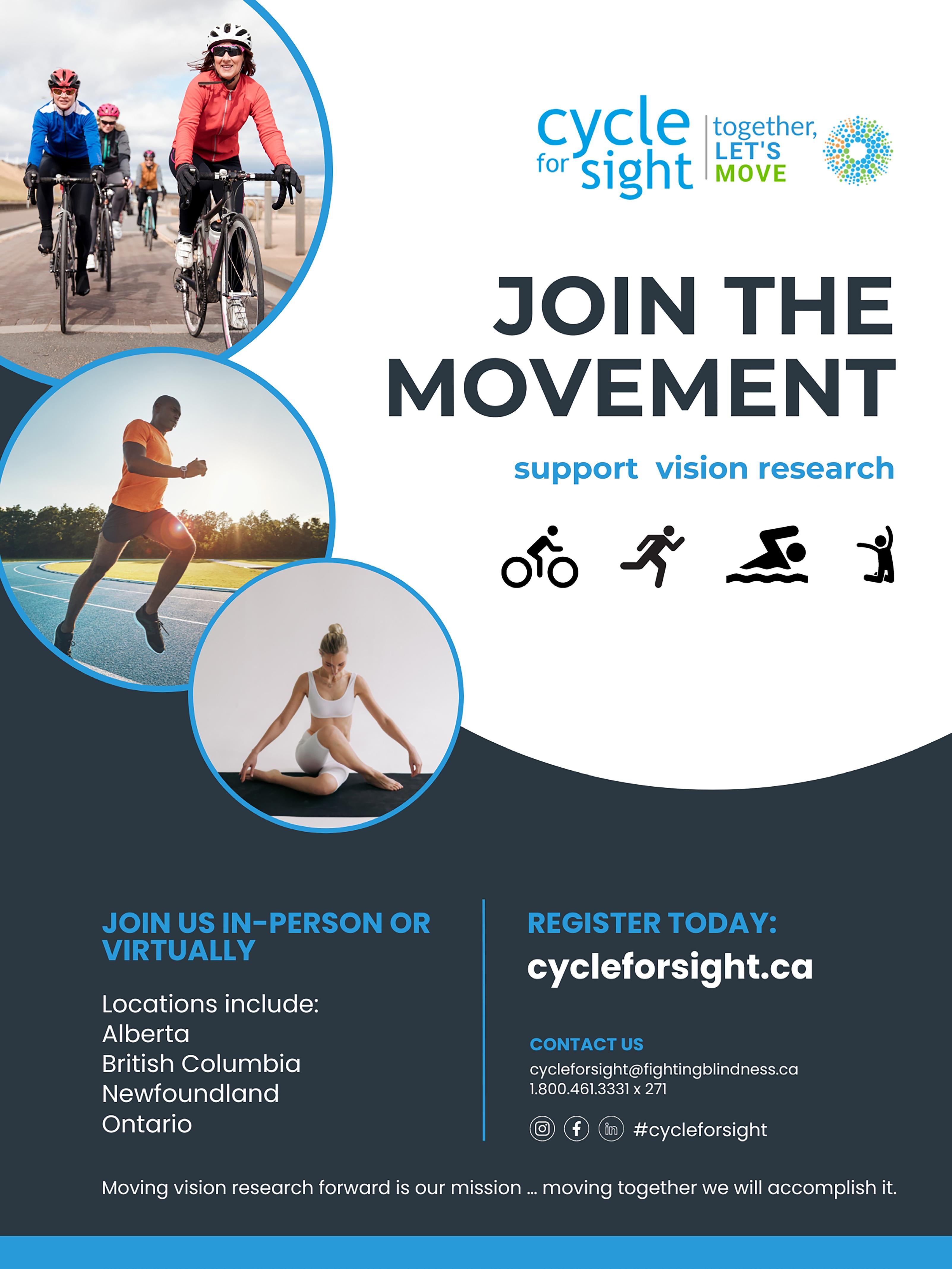
Advances in Stem Cell Therapy Made by FBC-Funded Researcher
 By Fighting Blindess
By Fighting Blindess
Canada
Cells grown in lab can reach out and connect to other retina cells.
Fighting Blindness Canada (FBC) funded scientist Dr. David Gamm (University of Wisconsin) has successfully shown that photoreceptor cells grown from stem cells can reach out and connect with their neighboring cells. Published in the journal PNAS, this study brings us one step closer to testing a stem cell therapy in humans in a clinical trial.

FBC-FunderResearcher, Dr. Gamm's Recent Findings
Funded in part by a FBC grant, Dr. David Gamm has been working hard to develop a stem cell therapy for advanced retinal degeneration. His team has previously demonstrated that they can grow groups of cells called organoids that resemble the retina, including photoreceptor cells.
In 2022, Dr. Gamm’s research team showed that the lab-grown photoreceptors do respond to light and extend out “cords” or axons towards other retinal cells in the organoid. But what would happen if the
organoid cells were separated and put into the eye? Would they be able to extend their axons and form new connections with other cells in the retina? This would be a key step to restoring vision because after a photoreceptor senses light, it has to transmit the signal to other retinal cells and finally to the brain where images are formed
Eye Digest Magazine | 13
“The last piece of the puzzle was to see if these cords had the ability to plug into, or shake hands with, other retinal cell types in order to communicate,” said Dr. Gamm.
To test this, the research team broke apart the organoids into individual cells and gave them time to grow their axons and see if they made connections with other cells. They saw that many of the cells, including photoreceptors did make new connections (called synaptic connections).
“We’ve been quilting this story together in the lab, one piece at a time, to build confidence that we’re
headed in the right direction,” describes Dr. Gamm, who has co-founded Opsis-Therapeutics which is adapting this technology to treat vision loss, “…it’s all leading, ultimately, to human clinical trials, which are the clear next step.”
We are excited to follow Dr. Gamm’s research team progress. This work was funded in part by a grant through FBC’s Restore Vision 20/20 program.
To learn more about stem cell therapy, visit fightingblindness.ca/eyehealth/innovativetreatments

14 | Eye Digest Magazine
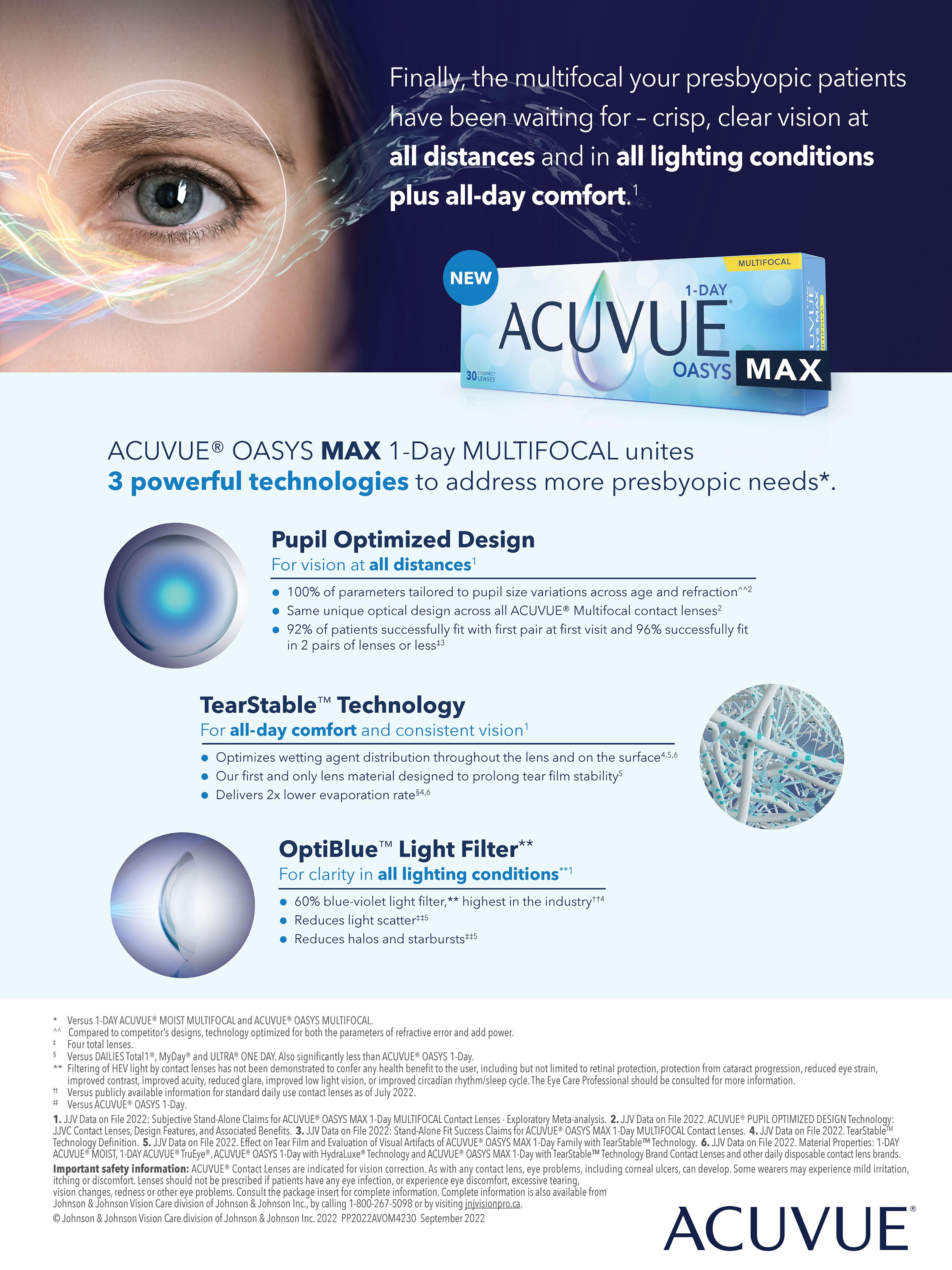
Shaping the Future of Eye Care
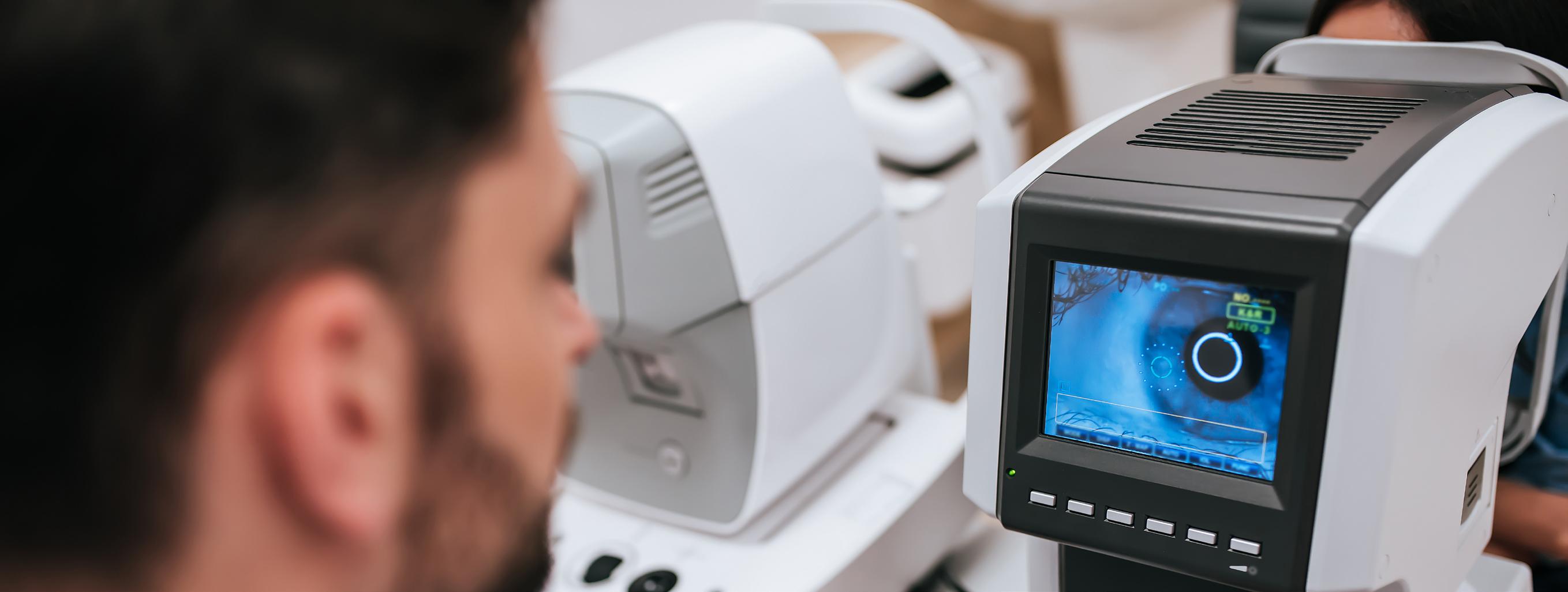 By Dr. Michale Chivers, OD
By Dr. Michale Chivers, OD
The expanding scope of Optometry
When I think back to when I first started practicing 20 years ago, I was one of the first classes to graduate from Waterloo with TPA certification. The ability to prescribe topical antibiotics and steroids was a significant change for our profession because we could finally provide timely and appropriate care for our patients. Another notable expansion to our scope was the ability to manage certain glaucoma patients. Advancements in OCT imaging have had a profound effect on supporting our examination skills to assist in earlier disease detection, diagnosis and management. There has also been an expansion of special areas of interest such as vision therapy, myopia management, scleral lens fittings and dry eye disease. Each of these areas requires its own specialized equipment and educational training. Our continuing education, technological advancements and the
need for health care providers will facilitate the expansion of our professional scope over time. The ability to prescribe some oral medications, order lab tests, remove skin lesions and perform certain laser procedures is likely to be a part of our future.
Our increasing role within the health care system
Our role as primary eye care providers is becoming increasingly important within our health care system. If someone has a concern with their eyes or vision, an Optometrist can help them. There is no other health care provider that the public has direct and timely access to with the knowledge, skill set and equipment to diagnose and either treat them directly or arrange their care with a specialist. As an example, a patient could call in with new floaters, be seen the same day, have a retinal tear discovered, and subsequently have
16 | Eye Digest Magazine
laser eye surgery done with the local ophthalmologist potentially within hours. This is just one of many scenarios I could have used but one I’m sure almost all optometrists have dealt with. In the future, our role is going to become more critical and we will need to respond by managing more emergencies as well as chronic eye health conditions. In addition, the requirements of what a comprehensive eye exam includes are going to increase. OCT imaging will likely become a required piece of equipment. Children’s exams will need to include myopic risk assessment and a review of management options. There will also be an increased need for dry eye assessment and treatment advice considering the dry eye epidemic affecting all ages of our population.
The optical retail side
One longstanding pillar of Optometry is our role as highly skilled refractionists and the provision of eyewear. This remains one of the main reasons people seek an eye exam. However, this aspect of our field is being increasingly sought after by a wide range of optical retail providers. The technology to do online refractions is here and legislation to protect the public from the risks associated with separating eye health exams from refractions is weak, particularly in BC. These optical providers will be quick to adopt online refractions. The ability of Optometrists to depend on their optical department to fund the medical care they provide cannot be guaranteed into the future.
Valuing our professional services

It is a long held tendency for Optometrists to undervalue their professional services. Our inclination to think this way has never been as prevalent as it is right now. The expectation that comprehensive eye exams should be performed at low or no cost has become a requirement of some corporate business models. The revenue from patient visits becomes largely or wholly dependent on the purchase of eyewear from the clinic. Optometrists practicing within this model could find it difficult to accommodate many patients in a day
that just require medical care. Managing chronic eye health conditions and branching into special areas of interest could become challenging under this arrangement.
What the future holds
Our profession has the opportunity to grow and expand in scope. The choices we make today in how our profession is valued will ultimately play a role in the extent to which we can take on complex care. Optometrists can rise to meet the needs of national health care shortages by practicing to their full extent. It is important that Optometrists as a whole ensure our profession is able to support itself based on our highly trained medical expertise going into the future. We all play a role in the stewardship of Optometry over the course of our career and it is our responsibility to ultimately leave this profession in a better state than when we first started.
Eye Digest Magazine | 17

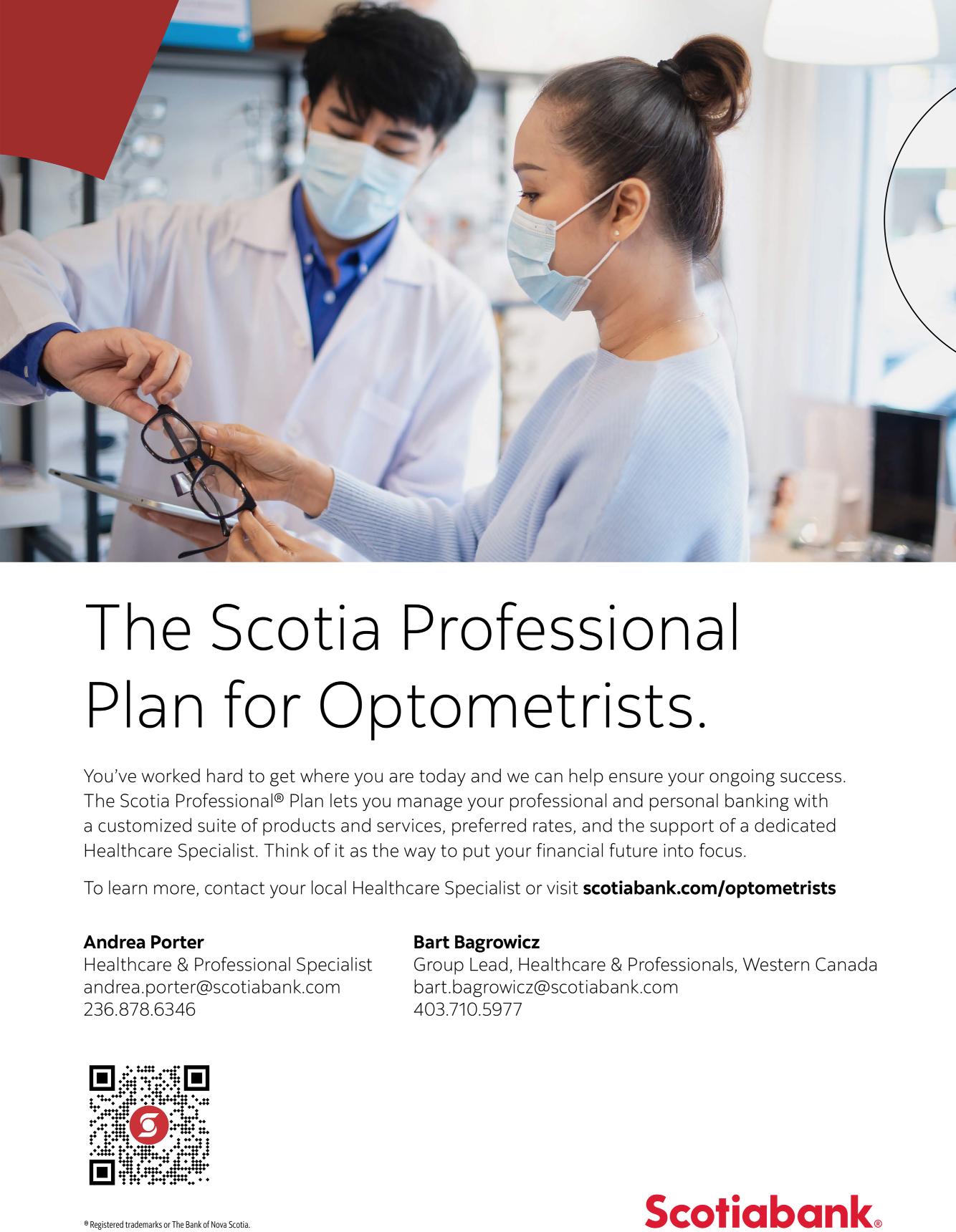
Five Key Tips for Managing OptometryYourClinic
By Scotiabank Healthcare & Professional Banking

As an established optometrist, you have the clinical skills to care for your patients. However, managing a successful optometry practice requires that you master a whole other set of skills as well. Like other businesses, you need to stay on top of more than just the day-to-day operations. Along with providing excellent customer service, you need to keep an eye on the bottom line and consider effective ways to grow your business.
Here are five tips that can help your practice thrive:
1. Surround yourself with the right team
As an optometry clinic owner, you wear a lot of hats. Along with being an optometrist, you have to be knowledgeable in areas like human resources, accounting, marketing and finances.
“One of the best strategies to help combat stress from managing multiple priorities is to surround yourself with the right people,” says Tom Apostolis, Regional Director, Healthcare & Professional Banking at Scotiabank. As a Director Apostolis leads a team of Healthcare Specialists that provides financial advice to many optometrists. He recommends finding an accountant that specializes in the profession who can help set you up with a sound business plan and structure for your prac-
tice. In addition, a lawyer can also provide important advice around legal considerations in running the practice, including human resource matters or reviewing lease or purchase agreements. Getting sound practice financing advice from a Healthcare Specialist and having a solid financial plan will help give you peace of mind and reduce financial stress. “When you’re time starved, it’s easy not to pay enough attention to certain things,” says Apostolis. “Having the right team can help ensure that doesn’t happen.”
2. Monitor your finances
Just as it’s helpful to get external legal and accounting advice, Lisa Nolan, Senior Healthcare Professional Specialist at Scotiabank, says it’s important for optometrist to get support with keeping a line of sight on revenue and expenses. Hiring a bookkeeper can ensure you’re managing your money wisely and monitoring billing and inventory costs in real time. For example, they can help determine if you are overstocked with supplies and merchandise and whether the extra money spent on inventory could be put to better use elsewhere, freeing up cash flow.
“When it comes to finances, one thing we also learned during COVID was the importance of
20 | Eye Digest Magazine
handling unpredictability as things can go astray. It’s crucial to keep a focus on paying down debt and maintaining revenue streams,” says Nolan. “You should always make sure to have a contingency fund set aside in a bank account or access to a line of credit to cover any unexpected expenses. Having a solid financial plan and reviewing it annually with your advisors is key to ensure you’re set up for success.”
3. Be a great employer
Finding and retaining suitable staff has become more challenging due to labour shortages in the marketplace. Consider ways you can differentiate yourself from other optometrists to attract and retain employees. For example, offer an enticing group benefits program, the option to work
flexible hours or a signing bonus if your operating budget allows. It’s a very competitive labour market and signing bonuses are becoming more common as employers compete for optometrist assistants and newly graduated optometrists.
Being a great employer also means making sure you are familiar with employment laws. “Be knowledgeable of human resources legislation, as there are many laws designed to protect employees,” says Nolan. It’s why she counsels all optometrists to make sure they have signed employment contracts for all staff to enforce the agreements and protect both parties involved should challenges arise. Again, having legal counsel in your circle of professionals is invaluable.

4. Differentiate yourself to help grow your business

In the current market environment it can be tougher to remain competitive. You may find yourself sometimes competing against businesses that have economies of scale and a streamlined capability to have lower costs for merchandise and equipment. Another way to market yourself is by carrying unique brands, brand names or latest styles in eyewear. Nolan’s advice is to always try to differentiate yourself. “Consider how providing a very personalized level of care can positively impact your client experience, resulting in repeat business and even referrals.” Creating a welcoming environment with your staff will allow patients to have a positive experience which will have an impact on customer loyalty and the bottom line.
Lavern Stewart, Senior Healthcare Professional Specialist at Scotiabank, says branding yourself and your clinic is important. Consider if there are certain services that you can offer to make your practice unique. For example, can you provide speciality services that other practices do not offer? Find ways to market these differentiators and make your community aware of your unique services.
5. Stay on track
Keeping your business on track requires that you
have a sound, workable business plan that can evolve along with your business. While the business plan should allow you some flexibility to follow relevant trends, you will also need to make sure the new expenses are not throwing you off track. “That means ensuring you always consider your return on investment,” says Nolan. “You need to evaluate the costs of veering from your business plan and validate that your return is worth while.”
You can’t control fixed expenses (such as rent) but there are flexible expenses like marketing that you can control and manage within budget. Nolan cautions, “If not, expenses can quickly get out of hand.” A business plan is essential because you can set objectives and forecasts to help manage short-terms goals, which can ultimately help you determine how best to bring in new clients and grow your business. Reviewing your plan regularly is a crucial component to adjusting for changes in circumstances or in the economic environment.
For more information and customized advice and solutions to help manage a successful optometry clinic, go to scotiabank.com/optometrists today.
22 | Eye Digest Magazine

In With the New
Consider these latest technologies to improve your diagnostics.
By Paul M. Karpecki, OD Chief Clinical Editor for Review of Optometry

Article republished from Review of Optometry
https://www.reviewofoptometry.com/article/right-tool-for-the-job
The old adage holds true for clinical practice—an accurate diagnosis is key to a successful outcome. The latest innovative diagnostic technologies are becoming mainstream either because they replace testing that patients don’t look forward to, replace those that are difficult to perform or simply provide critical clinical insights you can’t get elsewhere. Let’s review them.
Despised Tests
Let’s admit it—there are tests patients complain about, from manual refraction and binocular vision assessments to visual field testing.
Phoria testing is one such example, as most find it impossible to determine the misalignment endpoint. One might argue that this test belongs in the “difficult for the doctor to perform” category as well. The Neurolens Measurement Device, Gen 2, makes the task simple with an objective, repeatable test that takes less than two minutes. It acquires 10,000 data points and all misalignments are determined to an accuracy of 0.0μm. Contoured prism is prescribed, which has had a dramatic effect on my patient population in relieving asthenopia, headaches, neck stiffness, dizziness and/or dry eye sensation.
Another task patients (and techs) loathe is visual field testing. Patients get tired and frustrated with the button-pushing and insecurity of correct answers with standard automated perimeters (SAP). Because of this, it’s not uncommon for patients to fail to return to the office for follow-up testing. If you are looking for a VR headset, make sure it has active tracking—meaning the testing automatically halts if the patient loses fixation-— and options such as neighborhood cluster testing to ensure a quick test that typically is less than three minutes (M&S Technologies is one example).
ObjectiveField (Konan Medical), or the OFA, is a binocular, objective field analyzer that uses neurological pupil response to precisely map the visual field, with no button to push. Further setting OFA apart from SAP, both eyes are tested at once and novel diagnostic information such as mapped hyper-sensitivities and latencies, fellow-eye asymmetries and their respective progression analysis are captured.
Difficult to Perform Tests
There are assessments that we know are important but difficult for doctors or staff to perform consistently well, or lack the sensitivity to provide
24 | Eye Digest Magazine
useful information. For example, many patients with early glaucoma have a subtle relative afferent pupillary defect (RAPD), but I doubt many of us could pick up that level of asymmetry with the swinging flashlight test. Pupil testing with EyeKinetix (Konan Medical) provides a detailed neurological pupil testing assessment in about 90 seconds accurately and objectively. Early glaucoma is a common cause of these subtle RAPDs.
Ultrasound and other biometry measurements are difficult to obtain but helpful for myopia management. New devices such as Lenstar Myopia (Haag-Streit) or Myopia Master (Oculus) make testing more accurate and provide easy to follow patient reports with long-term tracking data.
Uncovering Clinical Insights
Diagnostics that provide insights beyond standard testing can add a level of sensitivity that increases our accuracy and prevents us from treating a patient who may not require it. One example is measuring hysteresis with the Ocular Response

Analyzer (Reichert). While IOP gives us an idea of risk, hysteresis provides a more accurate IOP, and it alone is the most accurate marker for determining who is likely to have a progression to glaucoma and risk of visual field loss.
Osmolarity is a key differentiator of DED. Far too many conditions such as eye misalignment, exposure keratitis, epithelial basement membrane dystrophy and blepharitis have symptoms similiar to dry eye. Putting such patients on dry eye treatments fails, is costly and is frustrating for doctors and patients. Osmolarity above 308mOsmol/L in either eye confirms a diagnosis. The new ScoutPro (Trukera Medical) is a single, portable handheld system that provides a precise tear osmolarity measurement in seconds.
Good diagnostics are the key to success in clinical practice. Consider new innovations that uncover essential clinical data or replace difficult tests— that’s essentially what innovation is meant to achieve.
Eye Digest Magazine | 25
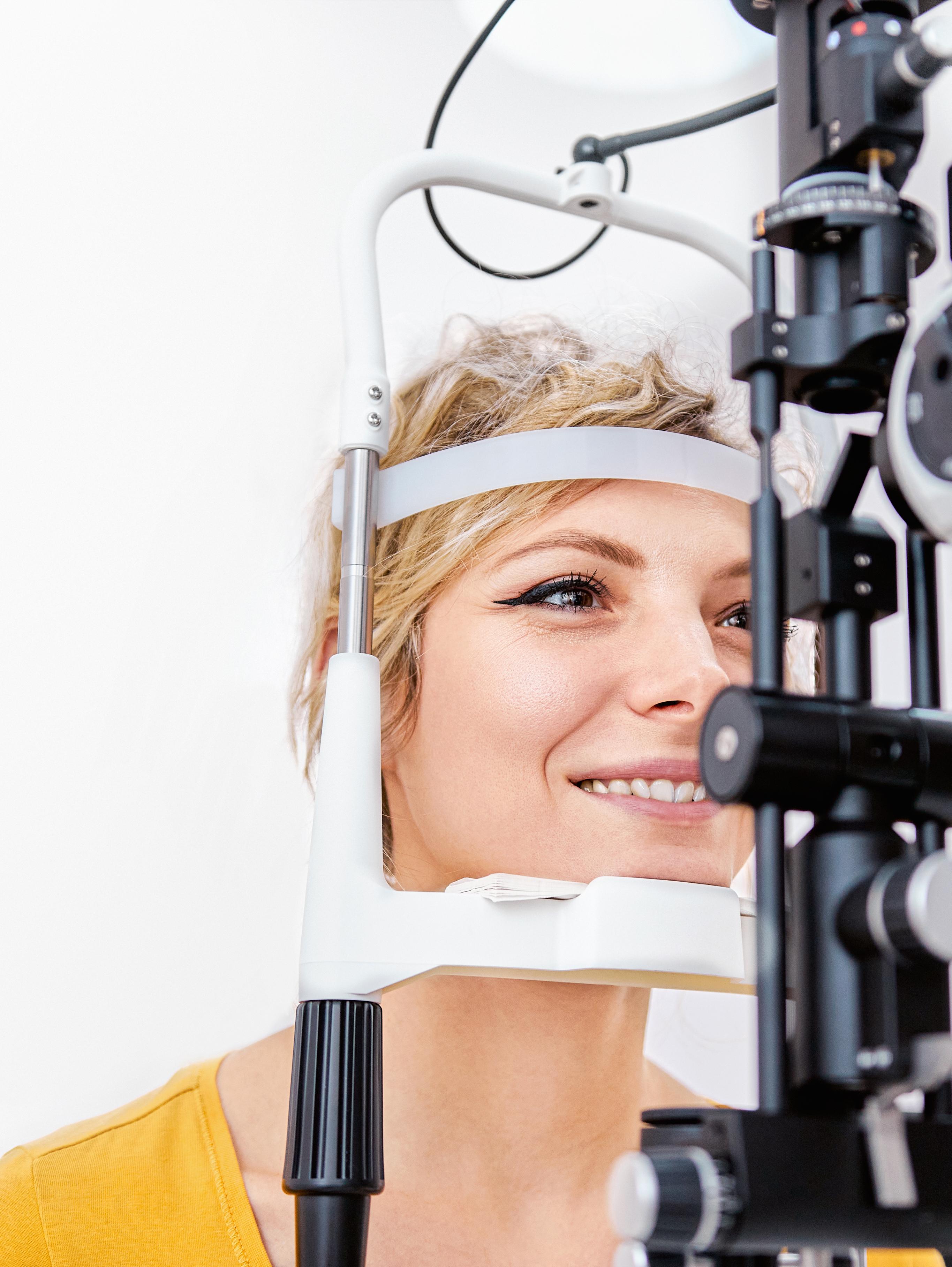
The Technology Suite that Helped Me Jump-Start a Fast-Growing Practice Right Out of OD School
By Susan Ly Johnson, OD, MPH, FAAO Owner, Boerne Vision Center, PA, TX
Your dream career as a practice owner can start shortly after optometry school if you have the right plan in place, including the technologies to help your new practice take off. I was fortunate to have a suite of Topcon Healthcare technologies to bolster my newly purchased practice, which blossomed into two locations in less than five years.
Gearing Up for a Career that Starts with Your Own Practice
Prior to starting optometry school, I shadowed the owner of a well-known optometry practice in Hollywood, Calif. The owner of this private pratice was inspirational to me, and made a huge impact on the career path I chose. She could set her own schedule, spending time with her family and doing charity work, all the while working in and promoting her business. I saw the difference in flexibility between being an employed doctor and a practice owner. I realized that my personality is much more suited to being the “boss lady” and determined to open my own practice as soon as I could.

When I was in my fourth year of optometry school in 2016, I reached out to private practice owners who had listed their practices for sale to see if
they were a good fit. My mentor from the optometry school’s private practice club helped me look through contracts and explained how to analyze the financials. During my residency in 2017, I finally found the right fit. I finalized the deal and began outfitting my office with everything, including technology, that I would need to provide great care and grow my business.
Finding the Best Technology to Prime Your Practice for Success
After researching a number of brands, I chose Topcon equipment because the product quality was outstanding and the instruments would work reliably for years to come. In fact, the practice I bought had a 15-year-old Topcon autorefractor that still worked perfectly.
For the first office we opened, I purchased a Topcon Maestro2 OCT and the KR-1 Auto Refractor. When it was time to open my second location two years later, Topcon was one of the first vendors I called.
Our doctors are excited about having this technology because they can easily show the patient their results in seconds on any digital device thanks
Eye Digest Magazine | 27
to the cloud-based IMAGEnet software. This helps our patients to understand their diagnosis, and thus be more compliant with treatment. As a practice owner, I appreciate that Topcon products help differentiate our practice while keeping our workflow running smoothly.
“I feel that my Topcon equipment has helped me to brand my practice as a state-of-the-art eye care provider.”
Our front desk staff is trained and incentivized ($1 per acceptance) to explain why the doctor recommends this additional testing. To streamline the patient visit, the technicians include the wellness scan in the pre-testing process, which adds two to three minutes to the workup time.
The wellness program has shown our patients that we are committed to eye health, while also generating a new stream of revenue. Last month, in just one of our offices, we brought in an additional $3,500 in wellness screening revenue.

Technology That Allows Us to Deliver Vision-Saving Care
My Topcon technology has helped me diagnose and manage many patients with eye diseases and conditions that could result in loss of vision, including:
Glaucoma
I track progression of the optic nerve with the OCT RNFL scan and optic nerve photos.
Patients on Plaquenil
I check for Plaquenil toxicity with the OCT Macula scan and fundus photos.
Corneal disease
The radial anterior segment OCT scan gives me 12 clock hours of corneal slices to examine.
Ptosis patients
I am able to take external photos that help me pinpoint potential problems.
Peripheral retinal changes
I take peripheral photos with the “auto-mosaic function” and piece the 9-photos together. It’s an easy photograph to capture and is very comfortable for the patient.
Creating a Wellness Exam That’s Good for Patients & Practice
We implemented an OCT “Wellness Exam ‘’ into our check-in process with the Topcon Maestro.
Technology that Eases Staffing Stress
Like all practice owners, I’ve struggled with staff turnover the past couple of years. In fact, I’ve had employees walk out halfway during their shift or simply stop showing up without notice. This new norm has made me incredibly glad that our Topcon equipment has touchscreen controls and intelligent automation, which makes it easy to learn and use.
Dr. Johnson uses technology from Topcon Healthcare to stay on top of patient care and to build a profitable practice, which has grown in a short time to two locations.
28 | Eye Digest Magazine


If you are a practice owner, then you are a leader. It is important to embrace the role, learn to excel as a leader and create future leaders in your organization.
Too often the owner abdicates the leadership responsibility and, as a result, the void is often filled by dysfunctional power grabbing protectionist team members looking to control everything and limit the growth of others.
Driving the Bus
As a leader, you need to be able to lead from the front. This component of leadership is tasked with the awesome responsibility of "being awake at the steering wheel". This means being ready to make turns to keep the bus on the road to business prosperity, to deftly dodge the potholes (like the Pandemic) and knowing when to stop, rest and refuel. The driver of the team understands what it takes to do each job to keep the team moving forward. Valuing each job is crucial to engaging the entire team to keep their eyes on the road so they can also catch threats that may end in disaster.
No Back Seat Driving
Great leaders let others lead. The bus of business is on the road 24/7. You can't be a good driver all the time. Encouraging other team members to lead perhaps by running a meeting, hiring new staff, creating training plans for each team member or investigating new product solutions are all key to fostering a Leadership Culture. It is important to let the driver in training make decisions such as where to turn without constant direction. Don't be a backseat driver!
Emerging leaders of organizations need some room to FAIL (First Attempt in Learning). Crucial to a learning organization is that reviewing where we are and how we got there brings new insights. All drivers in training need to know when they take a suboptimal route and understand ways to
improve on a go forth basis.
At the Back of the Bus
I remember road trips with soccer and hockey teams growing up. Only the "cool kids" got the back seats. The cover of invincibility and greatly reduced accountability made the back of the bus the most coveted locale. A great leader lets others drive. Encouraging and fostering leadership skills in others will incubate a culture of empowerment. Great leaders can sit at the back of the bus and enjoy the fun and reduced stress that comes with that. These special leaders are in tune with the heartbeat of the team. Make sure you take time to have fun!
Under the Bus
The concept of throwing a teammate under the bus needs to be revisited. Taking team accountability for mistakes such as a missed order, incorrect Rx, or any other perceived patient slight allows the patient community to recognize the team care they are receiving. As a leader, you should always be "under the bus" with the entire team. If we are attached together, we cannot throw anyone under the bus without ourselves going along for the ride.
The Wrong Bus
Sometimes passengers on your team bus may experience motion sickness or do not appreciate the direction the bus is going. In your company analogy, these passengers are wishing they weren't even on your bus. They want to fly first class (who wouldn't?!).
It is crucial that the leaders identify these team members and ensure they fully understand the direction of the organization and exactly what roles they are expected to undertake. If that is unsatisfactory to them, stop the bus and exit this employee. Perhaps a different journey is more suitable for them and it’s time for them to find a
Eye Digest Magazine | 31
different bus. It's better to be honest and frank in these conversations but remember to be kind.

Driving Standards
There are certain attributes that good leaders value including honesty, trust, hard work and kindness. In the same way that we follow "the rules of the road," great leaders don't cut corners when it comes to "doing things the right way." Crucially fostering other leaders is very important.
Great leaders create a pathway or "journey" for
each team member by overlapping training and compensation so that each employee feels some control of the direction that the team is heading.
Great execution relies on an amazing team all driving in the same direction!
32 | Eye Digest Magazine




Building a Successful Business Starts with a Strong Foundation
By Vishal Gill Founding Partner & Financial Planner Portfolio Planning INC.

As an optometrist running a private practice, you have dedicated your career to providing high-quality eye care to your patients. However, running a successful business require much more than just providing quality care. In order to ensure long-term success and growth, it is crucial to understand the importance of adequate insurance coverage for your practice.
Adequate insurance coverage protects you and your business from potential risk and liabilities, allowing you to focus on providing quality care to your patients for the long haul. Whether is is protecting your professional reputation, your physical assets, or your income, the right insurance overage can help you mitigate risks and losses, ensuring that your business continues to grow and succeed.
There are several insurance policies that optometrists should consider when running a private practice. One of the most important is professional liability insurance, which protects you against claims of malpractice or errors and omissions. This type of insurance is essential for optometrists, as
it protects their professional reputation and helps cover the cost of legal fees and settlements in the even of a claim.

Another important insurance policy to consider is property insurance, which protects your physical assets, such as your office equipment and fixtures. This type of insurance is critical for optometrists, as it helps you cover the cost of repairs or replacements in the even of a fire, theft, or other damage. For example, if a fire damages your office equipment, property insurance will help cover the cost of replacing it, allowing you to continue providing qualify care to your patients without interruption.
In addition to property insurance, business overhead insurance is also an important coverage to consider. This type of insurance protects optometrists again loss of income due to unforeseen events. Business overhead insurance is an expense reimbursement policy that covers the fixed monthly expenses required to keep a business running until the return of the owner, after a period of disability. This helps to ensure that your business continues to operate and helps you get
Eye Digest Magazine | 37
back on your feet as quickly as possible.
Having adequate insurance coverage also provides peace of mind. By having the right insurance in place, you can focus on your practice and your patients, confident in the knowledge that your business is protected. This peace of mind can help you maintain a healthy work-life balance and avoid becoming overwhelmed by the stress of running a business.
One of the biggest challenges that optometrists face when it comes to insurance is finding the right coverage the meets their needs without being oversold. With so many options available, it can be difficult to determine what type of coverage is best for your practice. That is why it is important to work with an experienced insurance professional who can help you understand your options and find the right coverage for your specific needs.
In conclusion, ensuring that you have adequate insurance coverage is crucial for optometrists running a private practice. By protecting your professional reputation, your physical assets, and
your income, the right insurance coverage can help you mitigate risks and losses, allowing you to focus on what makes your business succeed. Providing quality care to your patients and growing your business with confidence.

If you’re an optometrist in Canada and you’re looking to ensure that your business is protected, reach out to us today to schedule a complimentary meeting and find out how we can help you grow your business. With our experience and expertise, we can help you find the right insurance coverage to meet your specific needs, so you can focus on what you do best: providing quality eye care to your patients.
When it comes seeing your financial goals through, our vision is 20/20
Visit
38 | Eye Digest Magazine
us on social media @portfolioplanning or our website portfolioplanning.ca

BCDO is Giving Optometrists the Gift of Financial Wellness
 By Alphil Guilaran Co-Founder of Financial Literacy Counsel
By Alphil Guilaran Co-Founder of Financial Literacy Counsel

BCDO is improving the financial wellbeing of Optometrists by providing them exclusive access to benefits that will save them time, reduce money stress, and make more informed financial choices.
With ongoing inflation, rising interest rates and living costs, Canadians cite money as one of their biggest stressors. FP Canada’s (2022) survey1 found that 38% of working Canadians have ranked money as their biggest source of stress. Benefits Canada also found that 80% of Canadians want their employers to provide a financial literacy program 3, since they consider financial health as a critical component of their overall health and well-being. For business and clinic owners, the lack of financial literacy has a spillover effect, as a financially distracted workforce costs Canadian employers up to $40 billion/year in lost productivity 2 3
40 | Eye Digest Magazine
How is BCDO improving financial wellness and resilience?
By introducing BCDO’s Financial Wellness Suite, Optometrists now have access to the following benefits and resources to improve their financial health:

1.BCDO Help Desk
Your one stop shop to speak to financial, tax and legal experts to answer your questions. Whether you want to incorporate, have a contract reviewed, reduce taxes, or get a second opinion on your financial plan, the experts at Financial Literacy Counsel and MNP Chartered Professional Accounts are here to help.
Learn more and access this benefit today at https://flci.ca/bcdo-helpdesk/
2.Retirement Savings & TFSA Plan
Through Commonwealth, BCDO members now have access to an RRSP and TFSA plan with reduced management fees that help savings grow 2-3X further than an average RRSP and TFSA. Investments are professionally managed by BlackRock™.
If you are a clinic owner interested in setting up an
Employer Sponsored plan for your staff, you are more than welcome to use the Commonwealth platform as well.
Learn more and access this benefit today at: https://flci.ca/bcdo-suite-save/
3.Extended Health & Insurance Solutions
BCDO members now have exclusive access to health benefits not covered by MSP such as prescription drugs, dental and vision care as well as disability insurance. Improve and protect the wellbeing of you, your family and your staff through coverage from RBC Insurance and Edge Benefits.
Learn more and access this benefit today at: https://flci.ca/bcdo-suite-protect/
4.Health Spending Account
Incorporated
BCDO members now have access to a benefit that allows for the deductibility of healthrelated expenses. This can help Optometrists reduce corporate taxes and give them and their staff protection against rising health care costs.
Learn more and access this benefit today at: https://flci.ca/bcdo-suite-protect/
Eye Digest Magazine | 41
Your BCDO Financial Wellness benefits at a glance
BCDO is committed to your financial success, wellbeing, and resilience
Improve your financial wellbeing and resilience by embracing the power of integrated advice and the solutions provided through the BCDO Financial Wellness Suite.
Stay tuned as BCDO will be hosting webinars on how to effectively use the products and services of the Financial Wellness Suite starting this Spring.
It is human to worry. Ongoing inflation and a looming recession continue to keep us all in a state of uncertainty. The best gift we can offer ourselves and those who depend on us is the gift of financial literacy which can act as a guiding light through
of all this uncertainty. Learn how FLC’s 20 years of expertise has helped organizations, just like yours, improve the well-being of their employees and communities they serve.
References:
1. FPCanada. (2022). FP Cananda. Retrieved from https://fpcanada.ca/docs/default-source/financial-stress-index/2022-financial-stress-index-survey-results.pdf?sfvrsn=6595e8a_9
2. NewswireCanada. (2022). Retrieved from https://www.newswire.ca/news-releases/financial-stress-related-distraction-subtraction-costing-businesses-billions-875017579.html
3. BenefitsCanada. (2022). Retrieved from https://www.benefitscanada.com/news/bencan/ employees-financial-stress-costing-employers-40bn-in-2022-survey/#:~:text=Survey%20 finds%20employees'%20financial%20stress%20costing%20employers%20%2440BN%20 in%202022,-By%3A%20Staff&text=Employees%20worrying%20ab

42 | Eye Digest Magazine

 By Lauren Ward Communications Officer
By Lauren Ward Communications Officer
The University of Waterloo’s School of Optometry and Vision Science (UWOVS) is committed to addressing Indigenous initiatives for truth and reconciliation. Through a partnership with BC Doctors of Optometry (BCDO) to enhance education and outreach programs, UWOVS is focusing on cultural inclusion and safety in ocular health.

In response to the 2015 release of resolutions by the Truth and Reconciliation Commission of Canada (TRC), the University of Waterloo launched the Community of Practice to begin work in response to the TRC’s calls to action. One primary call to action is resolution 19, focusing on closing the gaps
in health outcomes by assessing long-term trends and the availability of appropriate health services.
From this came a blossoming relationship with the BCDO, who had already begun work within British Columbia to establish a connected network of optometrists to deliver eye and vision care services for First Nations communities, particularly those in remote areas.
The team at BCDO developed the framework to provide optometrists funding for travel and resources to reduce barriers. The collaboration with UWOVS aims to translate the BC framework into a starting blueprint for other provinces to support their efforts to improve patient access.

44 | Eye Digest Magazine
to improve patient access.
UWOVS is helping to evaluate Indigenous communities access to services. “Research must be done in close communication with communities,” says Adrianna Warren, a graduate student at the School of Optometry and Vision Science. “What their barriers are, whether it be cultural, distance, or perceived cost barriers.”
One way to reduce barriers is in providing tele-optometry, particularly when weather or geography prevents travel or ready access. With three pilot sites in BC, tele-optometry will connect optometrists to patients remotely. The intent is for tele-optometry to be a complement to the trusted, comprehensive in person eyecare already provided by optometrists.
While other provinces in Canada have optometrists doing similar outreach, oftentimes they are using their own minimal resources and carry the burden of additional expenses beyond what may be covered. From conversations with many optometrists doing this important work, there are some common themes and expectations that would be helpful to clarify for all stakeholders –providers, payors, and communities. UWOVS hopes to be able to learn from stakeholders about what works, what does not, and what could help to make the process more efficient and impactful.
“By reducing barriers, such as the cost to travel to rural communities, more optometrists may be

willing to provide care outside of their primary clinic practice,” says Warren. “This has an anticipated benefit of recruiting more optometrists to engage in rural practice.”
Another goal with this project is to work more with Indigenous people to spark interest in joining the profession, developing workforce capacity within community. Through education and recruitment, the idea is to train optometric assistants who are living in these communities, allowing for better representation and easier access to care.
“It is important to have a diversity of optometrists to care for the many different communities across Canada,” says Dr. Stanley Woo, director of the School of Optometry and Vision Science. “Cultural safety training is a great start for practitioners who are not from the community, but it is not a substitute for the lived experience. We want to support the potential of First Nations, Inuit, and Mètis representation in eye and vision care.”
A key lesson in our work thus far has been the realization that there is a lot of exciting and important work already underway. By harnessing that know-how, wisdom, and positive mindset, we can be even more effective through our efforts in supporting community priorities and access to eye and vision care. We strive to be a champion to increase and ensure access to care is equitable for all, while aspiring to bring stakeholders together to share in the call that we can do better together to achieve this.
Eye Digest Magazine | 45
By Kiljon Shukullari
 HR Advisory Manager, Peninsula Canada
HR Advisory Manager, Peninsula Canada
With trends such as ‘quiet quitting,’ and employee burnout dominating the news over the past couple of months, employee retention has never been more important. A high turnover rate negatively impacts not just your bottom line but is also, a red flag for potential new hires. It also has an adverse effect on the morale of the existing workforce. To improve employee retention, employers should build a strong workplace culture where employees feel valued and motivated to come into work. Remember, the work environment has a huge effect on overall staff morale.
Below are six-approved ways to help get an employee back on track and lead them to success.
1.Offer competitive salary and benefits
As a result of rising cost of living, many people change jobs for better pay. Offering a good compensation package makes employees feel valued and motivated. Ensure you are not underpaying, offer salary and benefits that are aligned with industry standards.
2.Provide clarity and transparency during the interviewing process
It’s important to be very clear on the job expectations and responsibilities from the beginning so there is no confusion. For example, if the job may require occasional overtime, it should be made clear during the interview. When the employee isn’t made aware of what is expected in a role, it can lead to work dissatisfaction and increased employee turnover.
3.Recognize and reward good work
4.Encourage a work-life balance
Overworked employees are at higher risk of feeling burnt out and stressed - causing them to be less productive. They are also more likely to view their work and workplace environment negatively. Encourage your employees to disconnect from work after their official work hours. It’s important to set realistic workload and deadlines. Set up one-onone meetings with employees to offer support and ensure their workload is manageable.
5.Growth opportunities
Opportunities for career advancement, or the lack of it, is also a reason why employees may want to switch jobs. Not being given the opportunity to grow within the company may leave employees feeling unmotivated. Talk to employees and ask what their career goals are and then provide them with the necessary tools and resources to advance in their careers.
You can also mentor your employees to take on new roles within the company and promote from within when looking to fill vacancies.
6.Allow for remote/hybrid/flexible work
Acknowledging the hard work of
employees
makes them feel valued and appreciated. Organizing work socials and holding contests around holidays with rewards, such as gift cards, is another way to keep employees motivated at work. Even a small gesture, such as a shoutout over team chats is a nice way to recognize good work.
If the nature of your business allows it, offer your staff the option of remote or flexible work. Remote work has also proved beneficial for staff with childcare or caregiving duties. Remote or hybrid work is also economical for your staff as they save time and money that would be spent commuting or eating out when working from the office. It’s a perk that’ll help your staff manage their finances. When they work remotely, your employees can also move to cities with lower costs of living.
Eye Digest Magazine | 47

Alcon Canada launches new TOTAL toric lenses for astigmatic patients
• Introducing TOTAL30 for Astigmatism and DAILIES TOTAL1 for Astigmatism: the first Water Gradient contact lenses for patients with astigmatism
• New innovations for patients with astigmatism aim to provide brilliant vision and exceptional comfort to the fastest-growing contact lens market segment*
TORONTO, February 2, 2023 – Alcon (SIX/NYSE: ALC), the global leader in eye care dedicated to helping people see brilliantly, today announced the Canadian launch of TOTAL30® for Astigmatism and DAILIES TOTAL1® for Astigmatism. This launch extends Alcon’s portfolio of reusable and daily disposable lenses, with high-performing options designed for astigmatic patients.
Estimates show that toric lenses – for astigmatic correction – is the fastest growing segment of the contact lens market,* presenting an opportunity for eye care professionals to provide outstanding vision correction and patient experience. Though 47 percent of patients require astigmatic correction, studies show only 10 percent of them wear toric lenses.1**
“We’re proud to bring TOTAL30 for Astigmatism contact lenses to Canada, alongside DAILIES TOTAL1 for Astigmatism lenses which have been tremendously successful in other markets,” said Chris Gruhn, General Manager of Alcon Canada. “These eagerly anticipated innovations will provide astigmatic patients with stable vision and outstanding overall comfort, delivering on our purpose to help people see brilliantly.”
Studies show toric lens wearers experience more discomfort compared to sphere lens wearers
(42% vs. 35%) and end-of-day dryness (35% vs. 26%).2 Featuring Alcon’s proprietary Water Gradient material, the new TOTAL toric lenses address these concerns, with a lens that is nearly 100% water at its surface so all that touches the eye is a gentle cushion of moisture.3,4
“Many contact lens wearers expect some discomfort or dryness to be the norm, and this is especially true for toric wearers,”2 said Dr. Christine Misener, O.D. at the Ancaster Eye Clinic. “My patients have seen success in TOTAL contact lenses, and now, I have a comfortable option for astigmatic patients too with the same innovative Water Gradient lens technology.”
These innovations also feature other proprietary technologies from Alcon designed to help provide patients with the ultimate wearing experience:
• The PRECISION BALANCE 8|4® lens design provides the on-eye stability astigmatic contact lens wearers need for exceptionally clear and stable vision.5
• The reusable, Water Gradient design of TOTAL30 for Astigmatism features biomimetic CELLIGENT™ Technology, which helps resist bacteria and lipid deposits for a clean lens all month long.6-9
• DAILIES TOTAL1 for Astigmatism features SmarTears® Technology, which releases an ingredient found naturally in tears that helps to stabilize the lipid layer of the tear film.4
Eye care professionals can visit www.myalcon. ca to find out how TOTAL toric contact lenses can benefit their practice and patients with astigmatism. Please see product instructions for full wear, care and safety information.
Eye Digest Magazine | 49
About Alcon
Alcon helps people see brilliantly. As the global leader in eye care with a heritage spanning over 75 years, we offer the broadest portfolio of products to enhance sight and improve people’s lives. Our Surgical and Vision Care products touch the lives of more than 260 million people in over 140 countries each year living with conditions like cataracts, glaucoma, retinal diseases and refractive errors. Our more than 24,000 associates are enhancing the quality of life through innovative products, partnerships with Eye Care Professionals and programs that advance access to quality eye care. Learn more at www.alcon.ca. You can also connect with us on Instagram and Facebook.
About Astigmatism
Astigmatism is a common vision problem with 47 percent of patients requiring astigmatic correction.1** Those with an astigmatism have an
irregularly shaped cornea, as opposed to spherical, which can cause fuzzy, blurred vision and make images appear stretched. Other symptoms of astigmatism can include headaches, eye fatigue and discomfort, squinting and difficulty with night vision.
References:
1. Young G, Sulley A, Hunt C. Prevalence of astigmatism in relation to soft contact lens fitting. Eye Contact Lens. 2011;37:20-25.
2. Multi-sponsor Surveys Inc. The 2014 Gallup target market report on the market for toric contact lenses.

3. Angelini TE, Nixon RM, Dunn AC, et al. Viscoelasticicty and mesh-size at the surface of hydrogels, characterized with microrheology. Invest Ophthalmol Vis Sci. 2013; 54:E-Abstract 500.
4. Pitt WG, Jack DR, Zhao Y, Nelson JL, Pruitt JD. Loading and release of a phospholipid from contact lenses. Optom Vis Sci. 2011; 88(4); 502-506.
5. In a clinical study wherein patients (n=66) used AOSEPT® solution for nightly cleaning, disinfecting, and storing; Alcon data on file, 2021.
6. Ishihara K, Fukazawa K, Sharma V, Liang S, et al. Antifouling silicone hydrogel contact lenses with a bioinspired 2-methacryloyloxyethyl phosphorylcholine polymer surface. ACS Omega. 2021;6:70587067.

Register Now

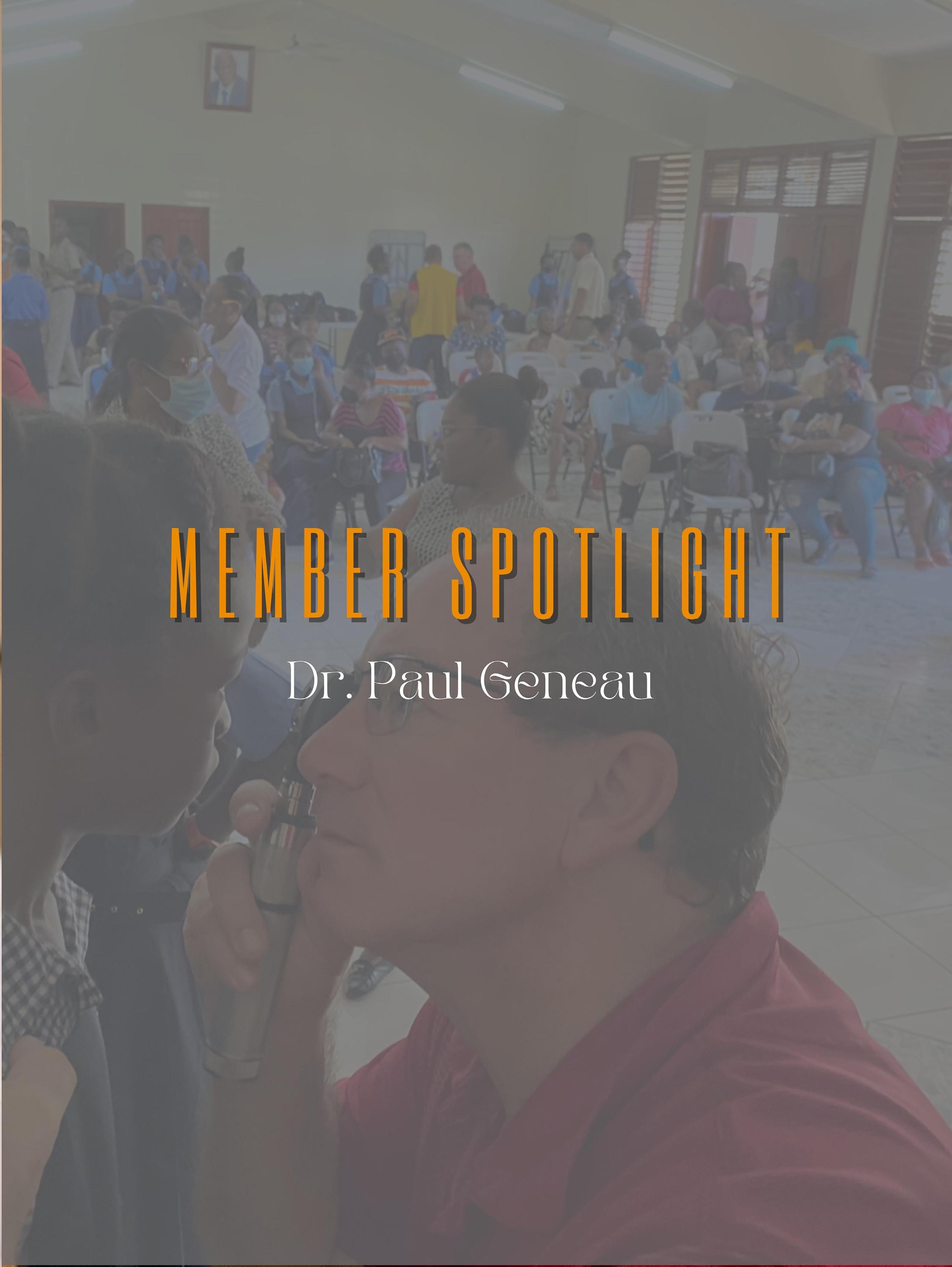
About Dr. Paul Geneau
Dr. Paul Geneau graduated from the University of Waterloo School of Optometry in 1981. He first practiced in Invermere, BC, from 1981 to 1989, and has been located in Nanaimo, BC since then. Dr. Geneau has always been very committed to his profession. He is a past president of both the Canadian and the BC Associations of Optometrists, and a past member of the board of the World Council of Optometry, still serving on its Membership Committee.
Dr. Geneau is the owner of Eye Care Nanaimo, a multi-doctor independent full scope practice, part the Eye Recommend network.
He has been an active Rotarian since 1981, and believes in Rotary's motto of "Service Beyond Self". A member of the Rotary Club of Nanaimo North, he has been president twice, and is deeply involved in the Rotary Youth Exchange program. He enjoys the deep satisfaction of facilitating exchanges that are powerful vehicles for youth to grow and mature, enjoying rich experiences, and becoming citizens of
the world. He is proud to be part of a program that helps build peace in the world, one exchange at a time.
Being attracted to volunteer work, and besides Rotary involvement, Dr. Geneau has travelled on over 50 eye care missions with Canadian Vision Care to Jamaica, Costa Rica, Philippines and Malawi. Almost every year he dedicates 2-4 weeks to these trips.

He believes that an optometrist is privileged to be able to give the gift of sight, and finds that it is an even more rewarding experience to be able to do so for people, in developing countries, that are without access to eye and vision care.
Dr. Geneau has been married to Cathy since 1979. They are blessed to have three children and nine grandchildren. They share a love of family, and of travelling, often combined with volunteer work.
54 | Eye Digest Magazine
1.How
do you define success?
Basically, success is just achieving one’s goals. Often, however, we judge others by perceived societal standards of acquiring wealth and assets, and achieving a high professional or social standing. But I feel that success is also journey, not a destination, and that there is no shame in abandoning goals that are no longer relevant or important, in favor of new or altered ones that are more realistic or in keeping with new priorities. Achieving a goal is a jumping off point to new goals, and not accomplishing a goal still provides learning and experience, and, hopefully, wisdom.
Presently, some of my goals are to gradually ease into retirement, while continuing to learn and develop clinical skills, and to lower my golf handicap to 10.

2.Who inspires you?
There are many people who inspire me, with their passion and service. Being a Rotarian, I am inspired
by the people I work with on the youth exchange program. In optometry, the many leaders that guide and support our profession are an inspiration. I also have several relatives who have overcome addiction and illness, with the support of family, and the hurdles they have overcome make my challenges seem minor.

Eye Digest Magazine | 55
Q&A with Dr. Geneau
3. What inspired you choosing optometry as your profession?
In high school, a computerized career counseling program suggested optometry as a career, based on my math and science proficiency. Simultaneously, a co-worker told me about her father being an optometrist and her goal to go to optometry school. The more I looked into it, the better suited it seemed for me. It turned out to be an excellent choice, and I have no regrets.
4. As a practicing optometrist, how does BCDO help you?
Having spent many years involved with the BCDO, the CAO, and the WCO, I appreciate how important it is to have a strong association that looks after our interests and provides opportunities for professional growth, and a foundation for collegiality

5. What are the most rewarding aspects of your job?
There is no such thing as a routine day. Every patient has a unique story, and many present an engaging challenge to problem solve. I have seen an amazing advancement in technology in my career that allows for more accurate diagnoses and better treatments. I became an optometrist to help people, and every
day is fulfilling.
6. What are 3 pieces of advice you have for new graduates?
• Graduating from optometry school is not the end of your education, but the beginning of lifelong learning.
• Be grateful that each patient is an opportunity to be of service, and to build an enduring relationship of trust.
• People don’t care what you know, until they know that you care.
Another Rotary axiom: “They profit most, who serve best.” In other words, the more you give, the more you get. Not just financially, but with personal satisfaction.
56 | Eye Digest Magazine

You know those people who always seem to have insider knowledge about savings? Those amazing promotions from big brands that the rest of us don’t know about? You’re one of them now.
As a member of BCDO, you have exclusive access to Perkopolis, Canada’s leading provider of fully managed perk programs. That means you get employee-preferred pricing from big brands like Apple, Lenovo and Samsung, plus hotels and car rentals worldwide. These are promotions that aren’t available to the public, putting you in the company of world-class savers across the country.

Here’s a peek at your perks:
• You get the best offers. We only work with great brands that we know you’ll care about – and who will provide a promotion that can’t be found anywhere else. Our sales experts know value when they see it and they don’t stop negotiating until they have the best offer available.
• You have your own custom platform. Log into BCDO's Perkopolis website on your computer, tablet, or smartphone to access and take advantage of offers designed just for you and your company.
• Get help anytime you need it. We have dedicated, bilingual customer service representatives available by phone, email or live chat. They’ll answer your questions, guide you through the buying process and provide any IT or other support you need.
• Be in the know about every deal. We create custom offers curated especially for you and your colleagues. You can choose to receive the latest news by newsletter, email, intranet or the Perkopolis app.
How to Register?
You can get your perks by registering for your account here. See registration instructions here.
Contact info@optometrists.bc.ca if you need your BCDO Member ID or have any questions about the benefit.
Please note that members signed up with Venngo will continue to have access to their accounts until the end of June 2023 during this transition period to Perkopolis.
58 | Eye Digest Magazine

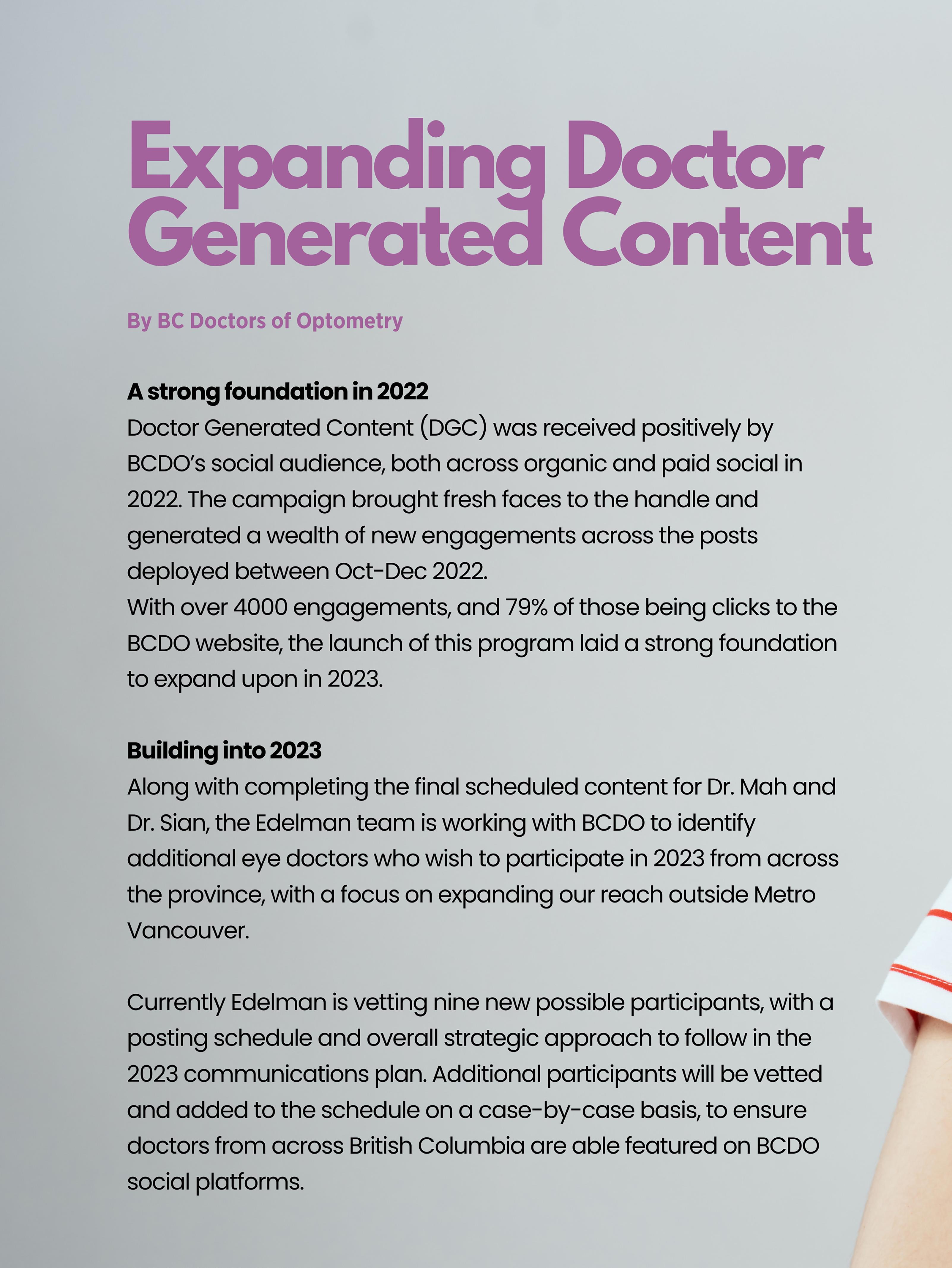


















 By Fighting Blindess
By Fighting Blindess



 By Dr. Michale Chivers, OD
By Dr. Michale Chivers, OD























 By Alphil Guilaran Co-Founder of Financial Literacy Counsel
By Alphil Guilaran Co-Founder of Financial Literacy Counsel




 By Lauren Ward Communications Officer
By Lauren Ward Communications Officer



 HR Advisory Manager, Peninsula Canada
HR Advisory Manager, Peninsula Canada


















